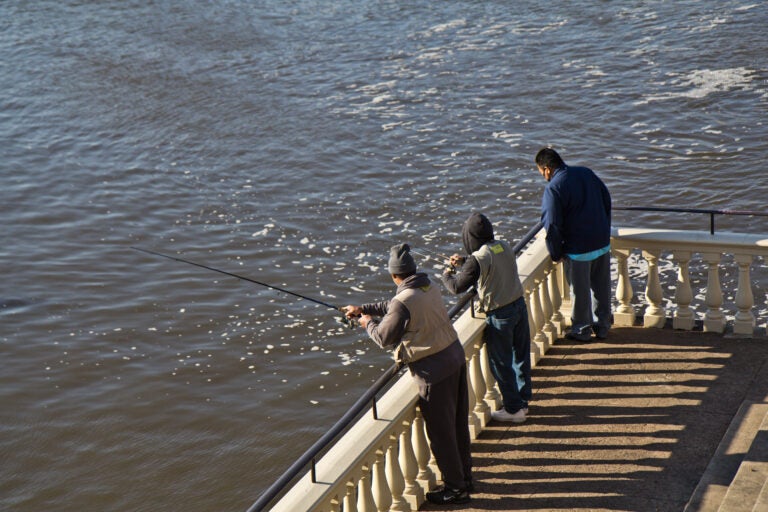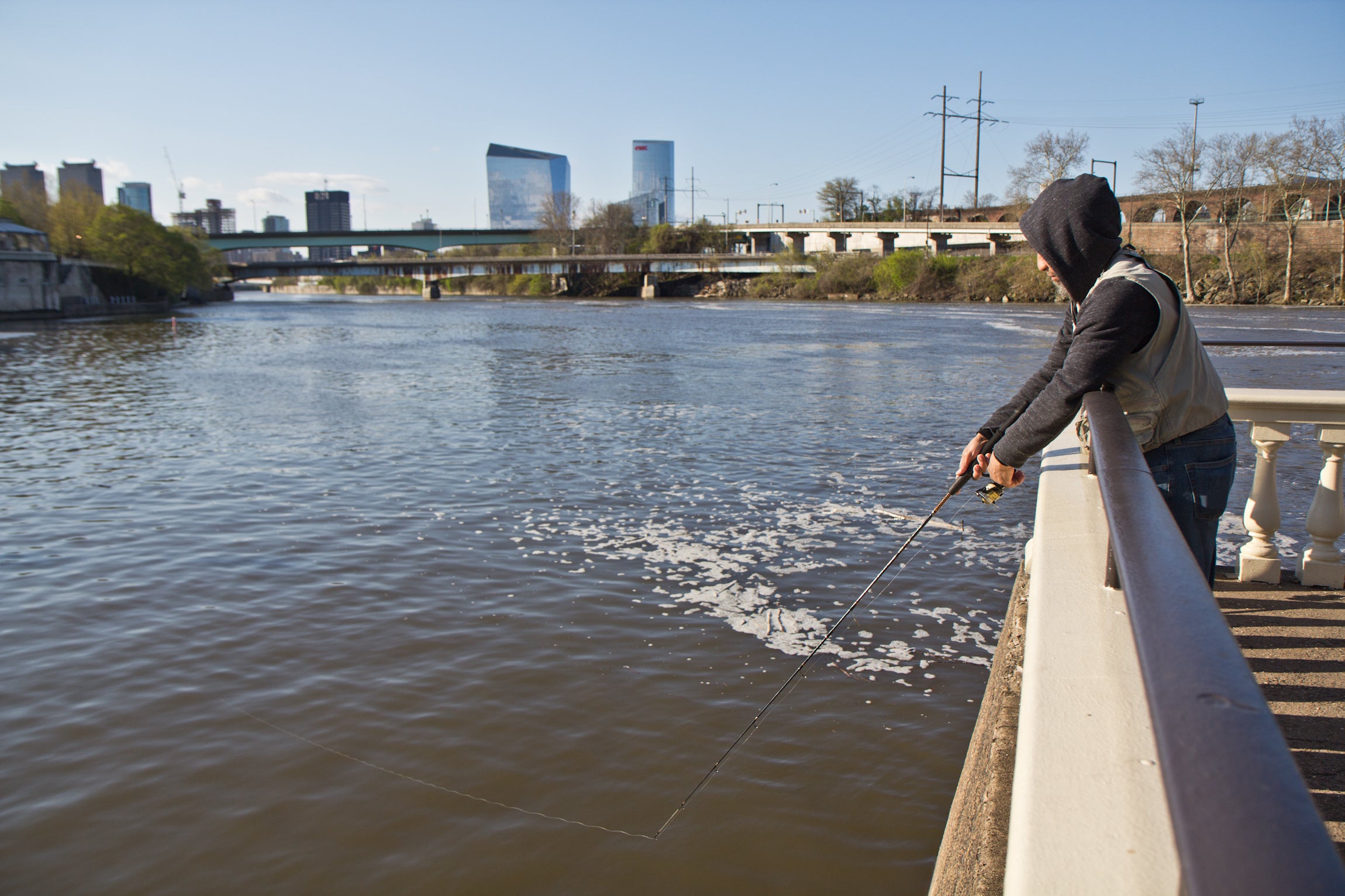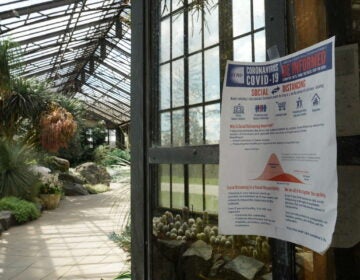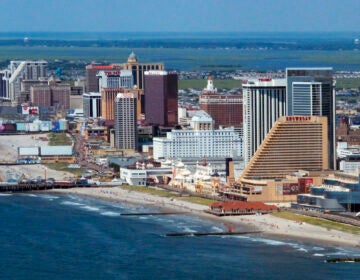It’s how you know the water is safe: the Schuylkill Rivercast turns 15
Pa. officials encourage fishing and boating close to home, with social distancing and no equipment sharing. The Rivercast predicts the water’s quality.
Listen 1:27
Philadelphians of all ages can learn to fish in the Schuylkill River this month at Philly Fun Fishing Fest, an annual catch-and-release fishing tournament hosted by the Philadelphia Water Department. (Kimberly Paynter/WHYY)
With stay-at-home guidelines firmly in place, many springtime activities — group picnics, carnivals, pool parties — are off-limits. That’s why some Pennsylvanians are pulling out fishing rods, dusting off kayaks and heading to the rivers.
State officials even encourage water activity. As long as would-be fishers and boaters practice social distancing, avoid sharing equipment between households, and travel no more than 15 to 20 minutes from home, it’s easy to practice COVID-free river use.
“We operate about 300 water-access trails, and all of them are open to the public,” Tim Schaeffer, executive director of the Pennsylvania Fish and Boat Commission, said in a recent statewide press call. “In terms of practicing social distancing while fishing, it’s really pretty easy … If you picture an arm and an outstretched fishing rod, that’s about the 6 feet of distance recommended.”

Then there’s the issue of water safety. A 5-second glance at the Philly RiverCast, a water-quality prediction site run by city employees, tells would-be fishers whether they’re clear to use the Schuylkill. But it wasn’t always like this.
“We would get calls: ‘Is it safe to swim in the river? We’re having the X Games, we are rowing and we plan to throw the coxswain in the water when we win’… [or] ‘We’re filming tomorrow at 8 a.m. What will the bacteria level in the river be? We’re doing stunts,’” Chris Crockett, the former manager of watershed science and engineering for the Philadelphia Water Department, told PlanPhilly in 2007. “No agency — state, federal or local — would tell them that.”
So, Crockett decided, he would. In 2005, Crockett received a $50,000 grant from the Environmental Protection Agency to create a system that would predict water quality and communicate it to everyday river users. And the Philly Rivercast was born.
Since its creation 15 years ago, not much about the RiverCast has been adjusted.
“There’s been some changes to the website, but for the most part, the proof-of-concept that we rolled out in 2005 and the way that we take information from the river to generate a forecast has not changed,” said Kelly Anderson. She’s the researcher and watershed protection program manager for the Philadelphia Water Department, as well as the woman behind the scenes of the RiverCast now.
‘A little bit of calculus’
How does the forecasting system work?
Unusually high bacteria concentrations — typically E. coli bacteria from either human or animal waste — are the primary factors that make river usage unsafe. But those bacteria concentrations can’t be tested and analyzed immediately. So instead, the RiverCast makes a prediction of water quality based on two other factors that often correlate with those critical bacteria levels: precipitation flow, or rainfall and turbidity, or water clarity.
Two river gauges, one at Norristown and one at Fairmount Dam, collect the water for testing, then feed real-time data into the forecast algorithm. The data is downloaded to the RiverCast every 15 minutes, and the algorithm creates a prediction for the level of harmful bacteria and assigns a safety level — either green, yellow or red — based on the conditions every hour.
“It’s not as straightforward as sometimes people think,” said Anderson. “The algorithm is not a live prediction … [It’s] taking into consideration variables that are live, but it’s comparing those two concentrations and samples that we have taken in the past at our intake.”
The prediction, she says, “takes a little bit of calculus.”
“Much like weather folks look and make predictions based off of models for weather forecasts, the RiverCast is a forecasting system that’s taking into consideration real conditions, but also comparing it against potential conditions.”
If it’s brown, don’t go down
Before the RiverCast, Anderson said, hopeful river users would usually revert to the “sight test” to decide whether it was safe to swim, fish or boat.
“If it’s brown, don’t go down … If it’s green, it’s pretty clean.”
Brown murky water, which is caused by mud from the river bottom, indicates that the river’s been agitated because of increased rainfall or upstream runoff. That runoff can contain chemical contaminants, litter, and animal waste from agricultural areas. In the case of storms big enough to overwhelm the city’s combined sewer systems, it can even contain human waste.

Climate change can also affect river health. The Schuylkill River drainage covers 2,000 square miles, Anderson said, so groundwater runoff, flooding, and other changing seasonal conditions can have an impact on the entire region. Though the Schuylkill RiverCast represents only the section of the river between Fairmount Dam and Flat Rock Dam, the river itself drains through the most populated section of Pennsylvania.
When the river calms, green algae herald its return to cleanliness — and water safety.
In the RiverCast, river users have a more accurate indicator of water quality before they go out. Still, the RiverCast predicts only as far south as Boathouse Row — in other words, it actually skips most of the stretch of the Schuylkill running through Philadelphia.
“Above the Schuylkill [Fairmount] Dam versus below the dam are two very different and distinct river systems … Downstream of the dam, you have a tidal river. Upstream of the dam, it’s nontidal and there’s no CSOs [combined sewer overflows],” said Anderson.
The stretch of the Schuylkill that flows through most of Philadelphia isn’t swimmable anyway, although it’s technically clean enough for fish consumption, according to state data on water quality standards in the Delaware River Watershed.
Anderson said she’s hoping for an increase in recreational river usage this spring. The RiverCast may not have changed much in the past 15 years, but Pennsylvanians have become increasingly interested in waterway activities. American Rivers even named the Delaware River watershed its “river of the year.”
At the same time, both state and local officials recommend exercising caution when using the river — and being particularly attentive to social distancing guidelines as recommended by the Department of Health and Gov. Tom Wolf.
Boathouse Row and all city-owned or controlled docks remain closed, according to Alain Joinville of Philadelphia Parks and Recreation. So do all state docks and marinas, in an attempt by the state to discourage large groups of river users.
“Tourism is important in Pennsylvania, and nature-based tourism is our bread and butter,” said Department of Conservation and Natural Resources Secretary Cindy Adams Dunn. “But like a lot of things now, we need to put human safety above numbers and visitation. Safety should be the prevailing mindset for a lot of people.”

This story is a part of Covering Climate Now’s week of coverage focused on Climate Solutions, to mark the 50th anniversary of Earth Day. Covering Climate Now is a global journalism collaboration committed to strengthening coverage of the climate story.
WHYY is your source for fact-based, in-depth journalism and information. As a nonprofit organization, we rely on financial support from readers like you. Please give today.




![CoronavirusPandemic_1024x512[1]](https://whyy.org/wp-content/uploads/2020/03/CoronavirusPandemic_1024x5121-300x150.jpg)



